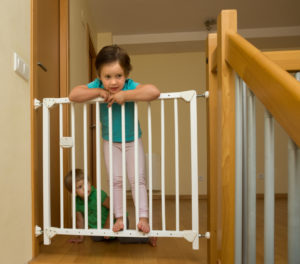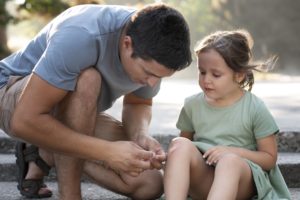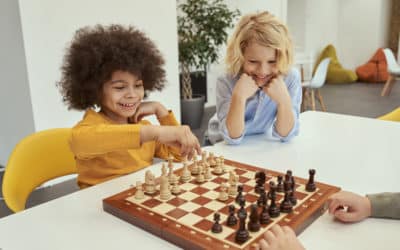Babysitting is a very rewarding and enjoyable activity, but it also has its share of unexpected and emergency situations. You need to be prepared for any eventuality. To help you manage in case of an accident, here is an article that includes the essential reflexes and first aid gestures to adopt in case of a problem.
What if we started by preventing domestic accidents?
The older the child gets, the more autonomy he gains. With that comes also the development of curiosity and what better way to discover this world than with the hands or the mouth. And so the safest place becomes the place of all dangers. As a babysitteryour responsibility is maximum. So, we invite you to read our article on how to avoid accidents in the home and how to babysit safely.
First aid gestures: basic reflexes in case of an accident
For your shift to go on in complete safetyPrevention of domestic accidents is very important, but since no one is safe, especially outdoors, it is essential to have the necessary basic knowledge and reflexes in case of emergency, namely :
- Knowing the emergency numbers.
- Clinics and hospitals near your duty station.
- Always carry a first aid kit with you.
- Know the pharmacies on duty: to find out which pharmacy is open closest to where you are on duty, contact the fire department or the police station.
- Keep your cool and adopt the right reflexes:
- Keeping the child and other children in your care safe
- Notify the emergency services
- Perform possible first aid procedures
- Preventing parents and Kidlee !
Learn first aid when you are a babysitter!
Regardless of the accident or injury, the first thing to do is to put the child in a safe place You must turn off the power in case of electrocution, move the child away from the stove/oven in case of burns, get him/her out of the water in case of drowning, etc.
Next, you need to quickly assess the child's condition. If the wound is light, you must disinfect the wound and put a bandage. Of course don't forget the magic kiss!
However, if the case is severe or confusing to you, It is necessary to call the 15th immediately: an emergency doctor will help you assess the situation and guide you through first aid. Always do this by putting your phone on speakerphone to be comfortable in your gestures.
After calling the ambulance, if necessary, look for help around you (relative, neighbor, passerby, etc.) to assist you.
First aid: how to react to the most common accidents
Us the child fall?
If the child suffers a fall violent at home or outsideIt is important to remain calm and act quickly without alarming the child.
If it is in a dangerous place, if it happens on the road for exampleYou must secure the area by calling passers-by to stand around the child.
Then, you must assess the situation, if you see that the child cannot move a limb or his whole body, if he loses consciousness, if he bleeds profusely or complains of nausea, dizziness ... you must immediately call the ambulance or the fire department by preventing the child from moving or being moved.
Reassure the child until help arrives and remember to keep an eye on him/her on other children that you keep if it is not the only one.
If, on the other hand, the child is able to stand up and move all of his or her limbs, and is not complaining of any symptoms, ask him or her to sit quietly, take some water and breathe. Check it outIf you have any bruises or swelling in the areas affected by the fall, go to the nearest hospital or clinic. If so, you should go to the nearest hospital or clinic.
A major bleed?
In a child, significant bleeding should trigger systematically a call to 15. Always do it on loudspeaker, so that you can do the necessary actions :
Start with compress at the site of the bleed, and then help the child lie down so that the blood can circulate better in the body. To stop the bleedingYou can compress the wound with the palm of your hand.
In relay of the manual compression, you can do a pressure bandage placing a cloth pad (clothing, towel, etc.) on the wound and holding it in place with a bandage sufficiently tight to stop the bleeding.
And if the injury is on the neck, only does manual compression without using fabric. Besides, in all cases, the hand is the best tool.
We also take the opportunity to prepare you for the Nosebleed in children because with the good weather, it is more frequent. First, ask them to blow your nose with a clean handkerchief. Then pinch the child's nose and tilt the head forward. If after 10 minutes the child is still bleeding you must immediately call for help.
Choking cases ?
Call 15 immediately and performs the necessary actions according to the situation. It is important to distinguish if it is an obstruction complete or partial.
If the child's mouth is open and no sound comes outthis means that the air no longer passes. So there is a risk that he will lose consciousness. In this situation, you ask him clearly: are you choking? If the child does not answer, it means that the obstruction is complete.
Start by giving him 5 pats on the back. If the object still does not come out, stand at the height of the object and press on the abdomen, so that abdominal compressions are performed, between the navel and the sternumThen go back up without the elbows pressing on the ribs. Repeat the operation 4 times.
Retape 5 times on the child's back if the object has not come out before help arrives.
On the other hand, if the obstruction is partialWhen the child is able to produce sounds, ask him to cough. Don't do anything gestures related to the complete obstruction, it may worsen the situation.
Loss of consciousness ?
When a child is unconsciousit is essential to prevent it to choke. He should be placed in the lateral position of safety (PLS).
This is also the case if the child is in respiratory distressfor example following a drowning. The gestures which save are simple, it is enough to stay calm and to operate progressively :
For a child over 2 years old:
- take the arm closest to you and place it at right angles to the child;
- take the other hand, palm to palm;
- positions the back of his hand against his ear and cheek;
- lift the knee least close to you;
- bring the heel closer to the buttocks;
- presses on the knee to tip the child without damaging the spine;
- gently withdraws the hand under his neck;
- raises the upper knee at a right angle to complete the stabilization.
Finally, don't forget to always keep this sheet nearby. It could be very useful one of these days!






